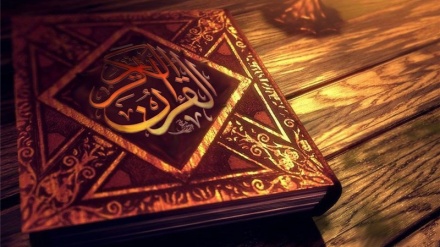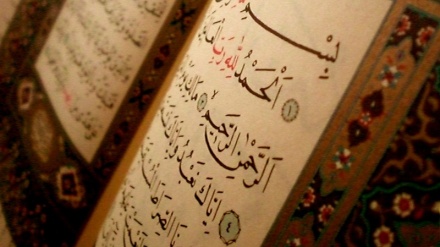Path towards Enlightenment (1049)
Welcome to our latest episode of “Path towards Enlightenment”, which is an endeavor to make you and us familiar with an easy and fluent explanation of God’s Final Scripture to all mankind, the Holy Qur’an that was revealed to the Last and Greatest of all Messengers, Prophet Mohammad (Blessings of God upon him and his progeny).
Last week we started explanation of Surah Muddassir, the 74th in order of compilation of the Holy Qur’an. It has 56 Ayahs and was revealed in Mecca as commandment for public proclamation of the message of monotheism without fear of the ringleaders of the pagan Arabs who were conspiring against the Prophet’s secret preaching of Islam. It opens by addressing the Prophet as “Muddassir” or the “One Wrapped in a Mantle”. It warns the obstinate disbelievers of their fate on the Day of Judgment and a specific opponent of the Prophet is singled out in Ayah 11. Towards its end, the Surah exposes the foolishness of the disbelievers’ attitude to Divine Revelation and the Day of Resurrection.
It is narrated from the Prophet’s 5th Infallible Heir, Imam Mohammad Baqer (Peace upon Him) that whoever recites Surah Muddassir in the obligatory ritual prayers, shall be elevated to accompany the Prophet and will be immune from the misfortune in this worldly life, provided he/she pays precise attention to its contents and acts upon them.
We continue from where we left you last Friday and here is Ayah 31:
"We have assigned only angels as keepers of the Fire and We have made their number merely a stumbling block for the faithless, and that those given the Book may be reassured, and the faithful may increase in [their] faith, and that those given the Book may not doubt and the faithful [as well], and that those in whose heart is a sickness and the faithless may say, 'What did Allah mean by this description?' Thus does Allah leaves astray whomever He wishes, and guides whomever He wishes. No one knows the hosts of your Lord except Him, and it is just an admonition for all humans."
If you might recall, in our explanation of the previous Ayahs of this Surah last Friday, we said it is not possible to properly understand the torments of the various parts of hell, other than what God Almighty has revealed in the Holy Qur’an and what the Prophet and his Infallible Heirs have elaborated on Divine command. We also said that both body and soul will be resurrected on the Day of Judgment, which means, the true believers shall fully enjoy and taste the bounties of Paradise, while those cast in hell undergo punishments and tortures. As reflected in Ayah 30, God Almighty has appointed nineteen angels (or nineteen groups) as guardians of hell. This number confused the obstinate polytheists and disbelievers and made some of them imagine that they could easily overcome the angels. They failed to realize that no power can confront God’s angels.
The Ayah that we recited to you now is a response in this regard that sheds further light by pointing out that the reason for mentioning the number of the angels who guard the hell is to test the faith of the people, both the faithless and the faithful. While obstinate disbelievers of the time of the Prophet of Islam tried to mock him, many of the ‘People of the Book” believed in his mission on finding the same number mentioned in their own previously revealed scriptures. This is ample proof that the All-Merciful Creator does not push people into confusion, but opens up the gates of guidance from which the seekers of truth benefit and firm up their faith while the habitual doubters in whose hearts is sickness continue to deny the manifest truth and are thus left to stray. In fact, the angels of God are not limited to the 19 angels or groups of angels, and as is clear by the phrases ending this Ayah, the angels, whose number only the Almighty Creator knows, are spread out all over the universe.
This Ayah teaches us the following:
- Angels are spread all over universe, both in the world in which we live and throughout the realm of the Hereafter.
- No reasonable person ever ridicules the philosophy of Divine laws, including the time of the daily ritual prayers and the number of rak'ats of each ritual prayer, as specified by the Prophet of Islam, obedience to whom is obedience to the Almighty Creator.
- Despite the interpolation and distortion of the previously revealed heavenly scriptures, many originalities still remain that conform to the indisputable message of the Holy Qur’an, and thus lead to solidarity amongst believers in contrast to the disbelievers and the deniers of truth, such as the obstinate polytheists and the atheists.
Let us listen to Ayahs 32, 33, and 34 the same Surah:
"No indeed! By the Moon!
“By the night when it recedes,
“By the dawn when it brightens;
These oaths by the Almighty Creator Himself are negation of the unfounded ideas of the disbelievers, and are meant to emphasize the raising of the dead on the Day of Resurrection, of the reality of hell, and of the torments awaiting the disbelievers. The Moon, in view of its regular rotation, brightness, beauty, and the lunar phases used as the standard for preparing calendars, is one of the greatest of Divine Signs. These three oaths are thus related and complementary, since the Moon shines serenely at night, its light fades when the night recedes at sunshine, and it is hardly visible when the dawn brightens into day.
The dawn signals the end of the night, and is the most delightful and the most beautiful ecstatic experience when the human heart brims with light and purity. It is noteworthy that these three oaths are in harmony with the Light of Guidance – that is, the Holy Qur’an – which when properly pondered upon removes the darkness of polytheism and atheism, resulting in the enlightening of the heart, mind, and soul with the brightness of monotheism.
From this Ayah we learn that:
- Natural phenomena, including the sun, moon, day and night, are the creation and signs of Almighty Allah, of whose Infinite Power we should be conscious all the time.
- It is thus wrong and illogical to think that natural phenomena came into existence by itself without the All-Wise Creator.
- These are admonitions for mankind to overcome negligence and avoid dangers that lie ahead, similar to a driver who is all alert in his vehicle speeding on the road, with proper attention to signposts in order to avoid accidents.
In conclusion of this week’s episode of Path towards Enlightenment we present you Ayahs 35, 36, and 37 Surah Muddassir:
“Indeed, it (resurrection) is one of the greatest [signs];
“A warner to all humans,
“[alike] for those of you who like to advance ahead and those who would linger behind."
These Ayahs are a reference to the undeniable reality of the Day of Resurrection which is indeed one of the greatest Divine signs, and a warning to all mankind including the believers and disbelievers, and not to any particular group of people. It is meant to encourage the firming of faith and doing of good deeds, as well as repentance from sins and disbelief by seeking forgiveness in the Divine court. Those who advance are the virtuous believers doing more and more good deeds, while those who linger behind are negligent people trapped in decadence.
From these Ayahs we learn that:
- Allah has provided us with ample means of guidance to avoid pitfalls and strive for His proximity.
- The warnings delivered by the Almighty Creator are meant for all, so that the disbelievers and sinners repent of their misdeeds, and the virtuous strive to further firm up their faith and do more good deeds.
RM/AS/ME


